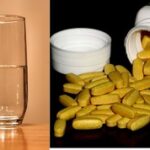Vitamin B in tea drink overview
Vitamin B in tea is mostly B2. It is a water-soluble vitamin. Vitamin B2 exists in the body in very small quantity. It helps form blood cells. This vitamin can regulate the break down of fats and amino acids. It also play an important role in energy production. This vitamin can also help maintaining healthy and young-looking skin. It increases the antibodies to fight off diseases. One of the most important benefits are that it reduces headache and it helps to concentrate.
Vitamin B2 or Riboflavin is very important to supply the cells with energy. This vitamin enhances cellular respiration and removal of carbon dioxide in the body. Cellular respiration is very important in cells’ growth and development. Vitamin B2 in tea also strengthens the mucous system, which is the external defense system of the body. Thus, vitamin B can help protect the skin and eyes from harmful substances. Recent studies also point out that this vitamin can help the body Food sources that are abundant in vitamin B: tea, meat (more abundant in the heart and liver), green plants and vegetables, eggs, milk, organ meat, cereal, bread, almonds, soybeans, and mushrooms. For milk, there is about 1.6 mg of vitamin B in 1 quart of milk.
According the Recommended Daily Allowance (RDA):
Males from age of 11 – 50 need ~ 1.7 mg
Males > 50 need ~ 1.4 mg
Females 11- 22 need ~ 1.3 mg
Females > 23 need ~ 1.2 mg
For young children, the daily allowance is much lesser. It’s best to consult with your doctor regarding young children’s vitamin B usage.
There is a wide range of symptoms the body uses to signal B-deficiency or B-overdose. People who are vitamin-B-overdose may experience pain in the tongue and throat, pale facial complexion, and dark-colored urine. Vitamin-B-deficiency individual can have some common signals including skin rash, itching, and brightly yellow urination. But these symptoms can also signal many other kinds of problems. You always must consult with your doctor before taking any action.
Vitamin A overview
Its scientific name is retinol. This component retinol is important in the formation of retina in the eyes. Its inactive form is beta-carotene. It is an antioxidant that protect the cells from aging and damaging. This vitamin enhances vision and promotes healthy eyes. This vitamin promotes milk production for breast feeding. It can also maintain healthy and radiant skin.
Vitamin A is sometimes known as Retinol. This vitamin is shown to enhance vision and promotes healthy eyes. It also plays an important role in strengthening the immune system by increasing the amount of white blood cells in the body. White blood cells make up our defensive system against harmful bacteria and virus.
Plants and animals contain different form of this vitamin. But once consuming into the body, these inactive forms of Vitamin A are transformed into active retinol. Beta-carotene is another inactive form of vitamin A. In the body, beta-carotene can efficiently turn into vitamin A. Beta-carotene has brightly orange color. Thus, rich sources of vitamin A include papaya, carrots, sweet potatoes, and mango. But there is also abundant of vitamin A in tea. So several green vegetables contain high level of vitamin tea include broccoli and spinach. Milk also is good source of this vitamin.
According to the Dietary Reference Intakes published by the Institute of Medicine, people in different age group needs different amount of vitamin A.
Children 1-8 needs 300-400 micrograms/a day.
Children > 8 needs 400-600 micrograms/a day
Male > 19 needs ~ 900 micrograms/a day
Female >19 needs ~ 700 micrograms/a day
Pregnant women may require different amount of vitamin A. Studies have shown that vitamin can increase the rate of milk production. Vitamin A in tea and fruits can have positive effects on skin cells. This helps to maintain beautiful and radiant skin. Vitamin A-deficiency can be caused by many reasons such as consuming low-vitamin-A foods, excess consumption of alcohol, or low intake of iron minerals – iron can help increasing the rate of vitamin A absorption into the body.
Vitamin A-deficiency people often have vision problems, diarrhea, and weak immune system. Children who are vitamin-A-deficiency often get sick very easy. People can provide the body with sufficient amount of vitamin A by drinking tea, eat more fruits, or take supplements. But it’s important that you should always consult with your doctor to which amount of this vitamin is sufficient for your body. There is several side effects if you consume too little or too much vitamin A. Too little vitamin A will cause visionary problems and weaken the immune system. Too much vitamin A will turn your skin yellow and weaken the liver.
Vitamin C overview
Green tea has about 0.002% of vitamin C. It is the most abundant vitamin in tea. Green tea has 10 times as much vitamin C black tea. Vitamin C is easily destroyed by heat and light. It travels in the blood stream and protects the cells. It helps strengthens the immune system. This vitamin can also help reducing defections in genes, thus lowering the risk of cancer. It can protect the digestive system from bacterial infections. It can reduces inflammation in the mouth and gums. Vitamin C play an important role in smoothing the blood flow, reducing the risk of heart attack and the levels of LDL (commonly known as “bad” cholesterol).
Usually, foods or drinks that have sour taste contains high level of vitamin C such as: green tea, orange , lemon, watermelon, tomato, green vegetables, strawberries, tangerines, sprouts….
Often, ~ 60 mg is sufficient for most people. For example, a cup of orange juice can supply your body with more than 100 mg of vitamin C, enough for 1 day. You may need more vitamin C in tea if you are suffering from a cold or your immune system is weak. Vitamin C in tea is water-soluble vitamin. Its scientific name is Ascorbic acid. Vitamin C is well-known to prepare the body against common cold and cough.
When encounter excess amount of vitamin C, the body tries to remove as much vitamin C as soon as possible. The cells only keep what they need to function and protect them against free radicals. Vitamin C in tea also helps increasing the absorption rate of iron into the body. Thus, vitamin-C-deficiency often accompany with iron-deficiency that may cause severe loss of sleep. Vitamin C also reduces fatigue, thus increase mental alertness and clarity.
The Recommended Daily Allowance (RDA):* for people > 16 year old is ~ 60 mg. Pregnant or breastfeeding women need even more vitamin C. (20 mg – 40 mg more). Young children from age of 1- 10 needs ~! 45 mg
Infant need less than 45 mg. But you should always consult with your doctor on the amount of vitamin C you should take. Overdose of vitamin C can cause dizziness and increase of urination.
Vitamin D overview
This vitamin is produced naturally in the body. It’s a fat-soluble vitamin. Vitamin D is produces in the skin in the presence of sun light. Less exposure ofsun light, the level of vitamin D decreases. This vitamin can also strengthen bones. A good companion to vitamin D is Calcium. Calcium is an important part of teeth. This mineral can prevent formation of brittle bones
thus can decrease the risk of bone fracture, joints pain, arthritis pain… Food sources that are rich in vitamin D are tea, beef, liver, tuna, eggs…
Vitamin D in tea is a very important vitamin to help strengthening the bones in our bodies. This vitamin can’t be dissolved in water. It’s a fat soluble vitamin. Vitamin D in tea and foods is in inactive form. Once in our blood stream, inactive vitamin D molecules are delivered to the kidney. There they are transformed into active vitamin D.
Studies have shown that vitamin D has the ability to increase calcium absorption rate in the body. An increase of calcium absorption helps strengthening bones and increases bone density. These effects can greatly help people, especially women and children, to reduce the risk of having bone fracture and many other bones diseases such as osteoporosis.
Rich sources of vitamin D include tea, eggs, beef, milk, and tuna. Vitamin D is only vitamin that is produced naturally by skin cells. Studies have shown that one hour/week of sunlight exposure produces sufficient amount vitamin D for the body. People who live in cold places who are exposed to little or no sunlight can easily develop vitamin-D-deficiency disorder. If the body can’t produce enough vitamin D, then this vitamin must be provided through diets. Different age needs different dosage (Talk to your doctor about how much dosage you need).
People at different age require different amount of vitamin D each day. This is because the rate of bone formation and bone breakdown is different at different stages of life. According to an article published by the Institute of Medicine, people from the age of 13 to 50 needs about 5 micrograms of vitamin each day. While people who are older than 50 years old requires 10 micrograms per day.
When we are young, the process of bone formation is much stronger than bone breakdown. When we reach the age between 25 to 40 years of ages, these 2 conflict processes are stable. The bones stops grow.As we age, the process of bone break down gradually takes over. When the calcium level decreases significantly, the body is forced to take calcium from the bones. Thus weakening the bones and increasing the risk of forming brittle bones and osteoporosis.
Also, as a person gets older, the liver is less efficient in transforming inactive vitamin D in foods to active vitamin D in the body. Women who are 55 or older need even more vitamin D. After menopause, women can lose as much as 2% of the calcium in the bones each year. Thus, increasing the amount of vitamin D can increase the level of calcium in the blood. Vitamin D in tea can be an important part of your diet. But caffeine in tea can decrease the positive effects of vitamin D on Calcium absorption rate. Thus, decaffeinated tea is probably a better idea. Each individual has a unique medical situation. Therefore, you should talk to your doctor before drinking tea or taking supplements to prevent any future complication.
Vitamin E in tea overview
It has antioxidant properties to protect the cells. The body needs fats to take in vitamin E. This vitamin plays a role in repairing damaged DNA. It can strengthen the immune system. It can also prevent blood clot, thus reduces the risk of heart attack. This vitamin can also protect the cells from harmful substances. One of the most important thing about this vitamin is that it helps regulate normal growth in the eyes.
Food sources of vitamin E : tea, mango, peanut butter, onions, lettuce, apple, walnuts, margarine, broccoli, soybean oil, olive oil, almonds….
Vitamin E is a fat-soluble vitamin and is a strong antioxidant in the body. Its scientific name is alpha-tocopherol.
Sufficient dose of this vitamin should be supplied to the body daily because it can’t be produced naturally in the body. Due its antioxidant property, vitamin E can protect the cells from free radicals and slow down the spread of breast and prostate cancer. Further more, vitamin E can help slow the oxidation process, thus decreasing aging rate of the cells. Vitamin E often is added to cosmetic products to slow down the aging process of the skin.
Vitamin E also helps lower the risk of blood clots formation, thus reducing the risk of suffering heart attack and stroke. Young children also need sufficient amount of vitamin E to healthy physical development. Overdose of vitamin E can cause uncontrollable bleeding. You must always consult with your doctor before providing your body with vitamin E in tea or in supplement capsules.
Vitamin K in tea
It’s a fat soluble vitamin. It can interact with enzymes to regulate blood clotting. This vitamin is produced in the liver. It is produced by vitamin-k-producing bacteria in the intestine. This vitamin can reduce the risk of excessive and uncontrolled bleeding. The most important thing is this vitamin can increases bond density to reduce your risk of broken or soft bone.
Vitamin K is a fat-soluble vitamin. There are 2 kinds of vitamin K. One form exist in vegetables like soybeans and cauliflowers. The other one is produced by colonies of bacteria that live in our intestine. It’s an important vitamin to regulate blood clotting process. Vitamin K in tea can full-fill this task by enhancing the effects of chemical prothrombin. Its effects in the body. This chemicals is responsible for the coagulation of red blood cells. Some food sources that contain vitamin K: tea, olive oil, soybean oil, spinach, egg yolk, cauliflower, mayonnaise…
According to the Recommended Daily Allowance ( PDR ): Adults > 18 needs about 60-140 mg. Young children 1-10 needs ~ 15 – 60 mg. Kids from 11-17 needs ~ 50 – 100 mg
These are only general guidelines. You should talk to your doctor as to what dose is suitable for your body. Overdose of vitamin K can lead to liver problems. In case of vitamin K deficiency, women may suffer from uncontrolled menstrual bleeding. For young infants, bleeding in the brain may occur. Infants (< 1 years) and pregnant women must always consult doctor before drinking tea or taking supplements for vitamin K.




